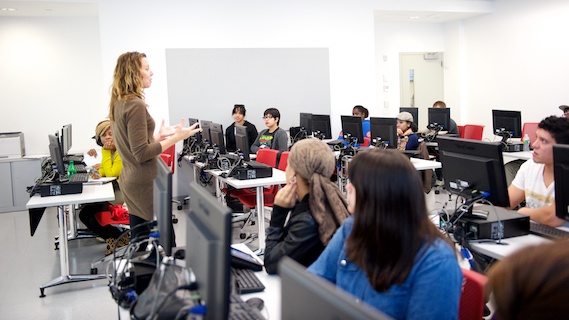
Students in Writing & Literature Professor Holly Messitt’s “Fiction Into Film” class are impressed with their new digs in Fiterman Hall.
“These chairs are nice, right?” a student asks, twirling for affect, and sliding up to his desk. He barely has time to unload his backpack, when Professor Messitt strides to the front of the room and announces, “Let’s have a quick quiz,” reading aloud questions related to their homework reading of the 19th-century classic Jane Eyre, by Charlotte Brontë.
Analyzing what’s essential
In the discussion that follows, Messitt refers to the movie Brokeback Mountain, which the class watched in addition to reading the short story by Annie Proulx, on which it is based.
“You can take the short story and fill in the gaps,” she says, “but how do you take a 500-page novel like Jane Eyre, and make it a 2-hour movie?”
“I would have a montage of her life, at the opening, get all her childhood out of the way,” a student volunteers.
“With voice over?,” Messitt asks, and the student thinks for a moment. “Yes,” she says, “and with classical music in the background … I would use a lot of voice over, to fill in the blanks.”
The class continues to debate which film narrative techniques would best convey the plot of Jane Eyre, and Messitt moves to the whiteboard.
“Let’s do a quick list,” she says. “What would be absolutely essential to include in the story?”
This process prepares students to write their own screen adaptation of a written work. As Messitt puts it, “They’re going to have to find the center of the story and make decisions about what to keep, what to combine, what to compress, and what to let go based on that center.”
From the practical to the aesthetic
Delving into the setting of Jane Eyre, she asks the class what the 20,000 pounds Jane inherits from her uncle would be worth today, and a student infers, “It was good enough to make her not feel like a poor person any more.”
Another student uses the computer at his desk. “I Googled it real quick,” he says. “A thousand pounds times 85, that’s what a pound in Victorian times would be worth today. It was like $2 million by today’s standards.”
The class moves easily from the practical to the aesthetic, as they analyze the story’s cinematic potential. In addition to reading screenplays, novels and short stories, they’re assigned critical essays on the works they cover.
“I have Writing and Literature, Theatre, Video Arts and Technology, as well as Liberal Arts students in the class,” says Messitt, “so there’s a nice conversation going on between narrative, character development, structure, and the conventions of film—light, movement, time, effects of different wide-angle and close-up shots, and so on.”
Salvation or redemption?
Earlier in the semester, when the class viewed the award-winning, 2005 film, Brokeback Mountain, “I was impressed by their sophistication setting up and analyzing the film,” Messitt says, “the way they saw the film’s structure, its narrative sequencing, explained the character development, and discussed the effects of cinematic techniques Ang Lee used in the film … They did a great job.”
Likewise, the students seem appreciative of their professor’s relationship with the texts she teaches, and when she shares having recently re-read Jane Eyre, admitting, “I was crying as I was reading,” a student asks, “How would you have felt if Mr. Rochester had died in the fire?”
This sets off a conversation about the novel’s themes.
“Can we think of this as a story of salvation?,” Messitt asks, and a student answers, “Maybe ‘redemption’,” referencing a concept they examined, as they read and watched The Shawshank Redemption.
The end
Finally, they tackle the motive behind Brontë’s choice of an ending for Jane Eyre.
“Let’s look at the very last page,” says Messitt. “If she wanted it to be about them, [Rochester and Jane], why did she end with St. John’s death?”
“A good movie makes you think about stuff,” a student posits. “I think instead of making this into a love story, I would focus on the religious stuff… how St. John [a former missionary] tries to force his religious views on others.”
Another student adds, “Everyone is so religious in this book, in one way shape or form. Do you think writing it was therapeutic for her, since Charlotte Brontë felt oppressed by religion at that time?”
Messitt draws their attention back to the text. “It seems that she rejects whatever is dogmatic,” she says. “One of the things we love about Jane is that she thinks for herself.”
This triggers a student’s epiphany. “In the first part of the book,” he says, “it’s like she’s going to be consumed by her passion and in the end, by her belief.”
“Teaching a piece of literature changes my relationship with it, even more so than writing about it,” Messitt reflects later. Whatever else students take away from the class, she’s certain, she says, “there’s one assumption they’ll find doesn’t hold up—that you can’t just watch the movie instead of reading the book.”
STORY HIGHLIGHTS
- Holly Messitt’s “Fiction Into Film” students read the works on which movies are based, and compare genres
- They analyze Shawshank Redemption, Brokeback Mountain, Jane Eyre and other works
- Students also write their own screen adaptations

